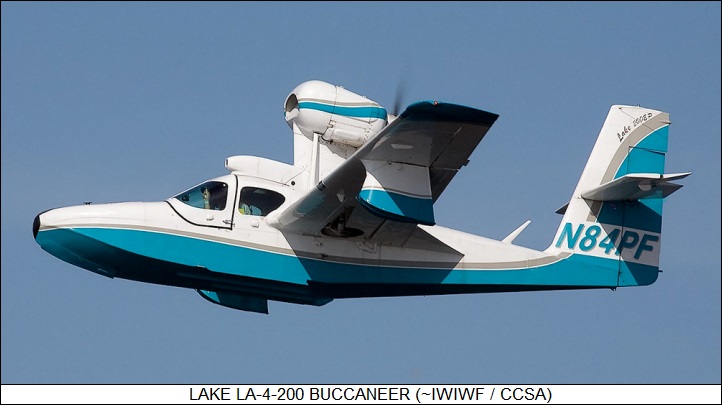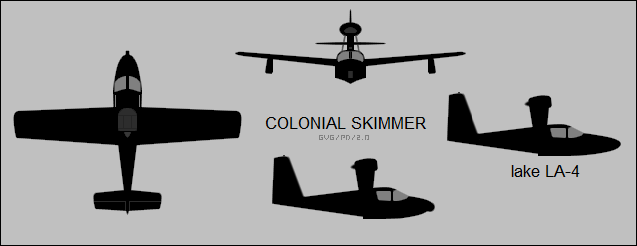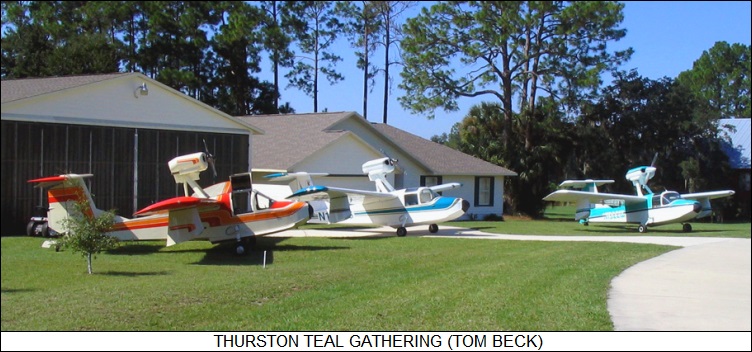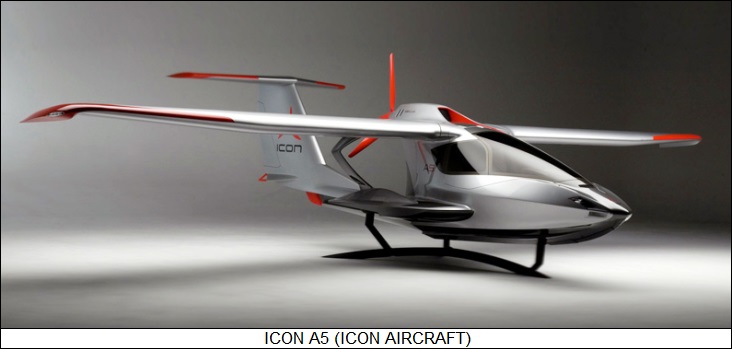
* In the immediate postwar period, there was a belief that private aviation was going to take off in a big way, with established aviation firms jumping into what was envisioned as a booming market. Such expectations proved over-optimistic, with firms scaling back their ambitions appropriately after finding public interest less than anticipated.
Part of this burst of enthusiasm involved development of light private seaplanes, most notably Percival Spencer's "Seabee" and a series of small flying boats designed by David Thurston, the best-known being the "Buccaneer". This document provides a survey of the Seabee and the Buccaneer family, as well as a number of other light civil seaplanes more or less inspired by them.

* Percival Spencer -- always known as "Spence", because he understandably didn't like being called "Percy" -- had been an aviation enthusiast since before the First World War, when he was a teenager, beginning to work on his own aircraft designs in the 1930s. In 1940 he set up his own firm, developing a two-seat amphibian flying boat, the "Spencer S-12 Air Car Amphibian", which performed its first flight on 8 August 1941. It was built of steel tube and fabric, featuring an angular cabin with a high wing, a slender low-mounted tail boom, and an engine mounted at the back of the wing / cabin, driving a two-bladed propeller in pusher configuration.
After the Japanese attack on Pearl Harbor on 7 December 1941, Spencer decided to get with the war effort, becoming a test pilot for Republic Aircraft Corporation, and putting the Air Car into storage. In the spring of 1943, Spencer left Republic and joined up with the Mills Novelty Company of Chicago, which was interested in the potential of the Air Car as a promotional gimmick for their company. Using the company's equipment, he came up with a new egg-shaped cabin for the Air Car; of course, the Mills Novelty Company was not likely to put the Air Car into production, so Spencer showed it off to his former employers at Republic.
By that time, Republic officials were thinking of what the company should be doing when the war came to an end. Expecting private aviation to boom once the fighting stopped, in December 1943 Republic bought up rights to the Air Car, modifying the design to all-metal construction. The resulting "RC-1 Thunderbolt" performed its first flight on 30 November 1944, with Spencer at the controls. The RC-1 performed public demonstrations; with a stated price tag of $3,500 USD, Republic quickly drew in thousands of advance orders. The US Army Air Forces and US Navy were also interested, placing large orders for the type, the primary intended use being for air-sea rescue. The Navy called it the "Seabee", which Republic then adopted for the civilian version of the aircraft.
In the wake of massive cutbacks following the end of the war in August 1945, the military orders for the Seabee were cut; it is unclear if the military ever got their hands on one of them. Work on the civilian Seabee continued, with the prototype of the production "RC-3" amphibian performing its first flight from the Republic plant at Farmingdale, New York, on 1 December 1945.
* As the production RC-3 Seabee emerged, it was a straightforward aircraft, with a certain sort of "art deco" style, built mostly of metal, with an egg-shaped forward fuselage and a slender tailboom, both riding on a stepped boat hull. It had a high strut-braced wing with fixed floats mounted just outboard of mid-span. It was powered by a Franklin 6A8-215-B8F or -B9F air-cooled flat-six piston engine providing 160 kW (215 HP), mounted in pusher configuration at the rear of the cabin, behind the wing. Images of surviving Seabees show them to have a three-bladed variable-pitch propeller, but apparently the RC-3 was originally built with a two-bladed fixed-pitch prop. The fuel tank was in the wing center section.
___________________________________________________________________
REPUBLIC RC-3 SEABEE:
___________________________________________________________________
wingspan:
11.5 meters (37 feet 8 inches)
wing area:
17.8 sq_meters (192 sq_feet)
length:
8.5 meters (27 feet 10 inches)
height:
3.1 meters (10 feet 1 inch)
empty weight:
995 kilograms (2,190 pounds)
MTO weight:
1,430 kilograms (3,150 pounds)
max speed at altitude:
240 KPH (150 MPH / 130 KT)
service ceiling:
3,650 meters (12,000 feet)
range:
840 kilometers (520 MI / 450 NMI)
___________________________________________________________________
The Seabee had taildragger landing gear, all gear with single wheels, the main gear retracting up and back to (not into) the fuselage, the tail wheel hinging up behind the rear of the boat hull. There was a water rudder behind the tail wheel. Flight controls were conventional -- ailerons, elevators, rudder, and one-piece flaps. There were seats for four, including the pilot, access being through a front-hinged car-style door on each side of the fuselage.

* Republic had hoped to sell 5,000 Seabees a year -- not so unreasonable compared to, say, high-end auto sales -- but the boom in private aviation didn't really materialize, and a postwar recession damped what enthusiasm there was for sport aviation, at least for a time. Republic had also raised the price, with a Seabee going for $6,000 USD in 1946, which was still cheap for what it bought, but also dimmed interest in the aircraft. Republic terminated production of the RC-3 in late 1947.
Republic still managed to produce a respectable 1,060 Seabees, these study and useful machines putting in good service. It was said to have some handling quirks -- for example, a stall speed that wasn't that much lower than the cruise speed, which could lead to some excitement if engine RPM fell off unexpectedly. It seems a few ended up in military hands with a few nations, though the specifics are very vague and unreliable. Several hundred Seabees were still flying at the end of the century, many being fitted with modernizations and improvements.
BACK_TO_TOP* The Seabee inspired a number of follow-on designs, though none approached the success of the RC-3. One was the "Twin Bee", a twin-engine conversion implemented by Joseph Gigante and his United Consultants (later STOL Aircraft) firm.
The Seabee, as produced, had no excess of power, and so Gigante decided to modify it into a twin. He yanked the Franklin pusher engine, stretched the tailboom assembly by 1.2 meters (4 feet), increased the span by 1.5 meters (5 feet), and installed a Lycoming IO-360-B1D air-cooled flat-four piston engine -- providing 135 kW (180 HP) each and driving a two-bladed Hartzell variable propeller -- in tractor configuration on each wing. The result had center of gravity problems, which were solved by increasing the size of the fuel tank and installing a new fuel tank in the tailboom, which increased range at the expense of some fiddling with fuel management during a flight.

Seating was also increased to five, with the doors hinged on the rear instead of the front. Changing the door hinge from front to rear was obviously motivated by the need to keep the occupants from stepping out into the prop arc -- but it also meant trouble if a door came loose in flight, since it would not only be all but impossible to close, it would strike the prop arc. The doors were implemented with additional latching and warning lights to indicate if they weren't locked. The first conversion was performed in 1960, with 23 updates sold from 1965 to 1987, making the Twin Bee a very rare bird.
* The Italian Nardi firm came up with their own answer to the Seabee in the 1950s in the form of the "FN.333 Riviera", flying an initial prototype in 1952, with two more prototypes built by Nardi through the decade. In the wake of the second Nardi prototype, Fiat of Italy also built two FN.333 prototypes, but did not continue with the exercise. Following the third Nardi prototype, production rights were obtained by SIAI Marchetti, with the first production machine rolled out in February 1962. Roughly two dozen Rivieras were built through the 1960s -- the exact number being hard to determine, because of double-counting of serials.
As it emerged, the Riveria showed obvious influence from the RC-3 -- egg-shaped fuselage, with seating for four and car-style doors, on a boat hull with a high wing and a pusher propeller engine -- but it was also distinctly different, most notably in using a twin-boom tail, with the booms fitted to the rear of the wing.
___________________________________________________________________
SIAI MARCHETTI FN.333 RIVIERA:
___________________________________________________________________
wingspan:
10.4 meters (34 feet 1 inch)
wing area:
15.1 sq_meters (163 sq_feet)
length:
7.3 meters (24 feet)
height:
3.23 meters (10 feet 7 inches)
empty weight:
1,045 kilograms (2,300 pounds)
gross weight:
1,485 kilograms (3,270 pounds)
max speed at altitude:
285 KPH (175 MPH / 155 KT)
service ceiling:
5,640 meters (18,500 feet)
range:
1,390 kilometers (865 MI / 750 NMI)
___________________________________________________________________
The Riviera also differed in using tricycle landing gear -- the nose gear tucking up into the forward hull, the main gear hinging up to be stowed in the fuselage -- as well as retractable floats, hinging up to mate with the wingtips, and no wing bracing. The twin tailfins were of trapezoidal configuration and had forward fillets. Powerplant was a Continental IO-470-P air-cooled flat-six engine with fuel injection, providing 185 kW (250 HP) and driving a two-bladed propeller.

The initial prototype, incidentally, had "guitar-pick"-style tailfins, and was powered by a Continental engine with only 110 kW (145 HP); there had been thought of fixing the floats to the wingtips and then folding the wing downward after water landing, but the idea didn't survive close examination. A handful of Rivieras still remains flying, though like the Twin Bee, it is a rare bird.
* A Canadian firm named Trident Aircraft LTD of Vancouver, BC, tried to resurrect the Seabee in the form of the "TR-1 Trigull" -- two flight prototypes being built, the first performing its initial flight on 5 August 1973, the second taking to the air in 1973. The Trigull resembled the Seabee closely enough to be confused with it, Spence Spencer apparently having a hand in the design. The Trigull could be distinguished from the Seabee by the angular swept tailfin; floats that retracted up to the wingtips; and tricycle landing gear -- the long stalky main gear hinging to retract outward into the wings, and the nose gear pivoting up to retract into the nose.
Production machines were to be powered by a Lycoming IO-540-M1A5 air-cooled flat-six engine, with 255 kW (340 HP), though the prototypes were powered by the less powerful Teledyne Continental Tiara flat-six. The Trigull was about a tenth longer and a tenth heavier than the Seabee, and could have seating for four or six, the rear seat in the six configuration apparently being intended for kids; it would be pretty cramped for adults.
Trident never got the Trigull into production, the company going under in the early 1980s. Viking Air LTD of Vancouver obtained the rights to the Trigull; Viking, incidentally, also has rights to de Havilland Canada classics like the Beaver, Otter, and Twin Otter, performing turbo conversions of Beavers and Otters, plus building Twin Otters new. Viking has dropped hints of producing the Trigull, presumably to see if there was any interest, and saying that a production machine would have a turboprop powerplant. Apparently there wasn't any interest, since it never happened.
BACK_TO_TOP* Following World War II, aircraft designer David Thurston, then of Grumman, formed the Colonial Aircraft Corporation as a side job, beginning work on a two/three-seat amphibian, the "Skimmer". The initial flight of the Skimmer prototype was on 17 July 1948, the type obtaining certification in 1955 and going into production as the "C-1 Skimmer". By that time Thurston had quit Grumman, and was working at Colonial full-time.
The Skimmer C-1 was a small flying boat of all-metal construction, with mid-mounted wings featuring a noticeable dihedral, and fixed fin-style floats. It had a tail with a mid-mounted tailplane, and tricycle landing gear -- all gear assemblies with single wheels, the main gear pivoting from the wings in towards the fuselage the nose gear semi-retracting upward into the nose. Ground steering was by differential braking, the nosewheel being free-castoring. The exposed retracted nosewheel looked a little klunky, but it served as a bumper for coming up to a dock.

Length was 7.16 meters (23 feet 6 inches), wingspan was 10.4 meters (34 feet), and empty weight was 655 kilograms (1,450 pounds). The powerplant was a Lycoming 0-320 air-cooled flat-four engine with 110 kW (150 HP), mounted on a pylon above the rear of the wings and driving a two-bladed Hartzell constant-speed prop in pusher configuration. The prototype had used a Lycoming O-290-D engine with 95 kW (125 HP). Apparently this engine placement had the odd effect of forcing the nose down when more power was applied, which took a bit of getting used to.
Flight control configuration was conventional, with flight surfaces manually actuated, except it appears for hydraulically-actuated flaps; there was a fold-down sea rudder at the base of the air rudder. Access was through a hinge-up front windscreen panel on each side, with side-by-side seating up front and a baggage area behind, which could alternatively handle a second passenger sitting sideways.
Production totals of the C-1 Skimmer are given as 22. It led to the improved "C-2 Skimmer IV", which was externally all but identical to the C-1 Skimmer, the primary change being an uprated O-320-A1A engine providing 135 kW (180 HP), permitting a higher maximum take-off weight. It was said to have seats for four, it being unclear if there was some internal cabin modification to increase space, or if two seats for kids were crammed into the back.
20 C-2 Skimmer IV machines were built, and then the Skimmer design was bought out in 1959 by what would become, after a series of difficulties and shufflings, Lake Amphibian Corporation. The initial Lake prototype, the "LA-4P", very similar to the C-2 Skimmer, performed its initial flight in November 1959; it was followed by two "LA-4A" prototypes in 1960, which featured a 1.22-meter (4-foot) wingspan stretch, and structural reinforcement.

* The LA-4A in turn led to the production "LA-4", which featured a bow stretched by 43 centimeters (17 inches), with the nose gear now fully retracting. Powerplant remained the O-390-A1A, which was something of a problem since the aircraft was underpowered, limiting customer enthusiasm. Total production of the initial model of the LA-4 appears to have been about 70 aircraft, including a one-off pure seaplane with no landing gear.
___________________________________________________________________
LAKE LA-4:
___________________________________________________________________
wingspan:
11.58 meters (34 feet 1 inch)
wing area:
15.8 sq_meters (170 sq_feet)
length:
7.6 meters (24 feet 11 inches)
height:
2.84 meters (9 feet 4 inches)
empty weight:
725 kilograms (1,600 pounds)
MTO weight:
1,090 kilograms (2,400 pounds)
max speed at altitude:
220 KPH (135 MPH / 115 KT)
service ceiling:
4,270 meters (14,000 feet)
range:
1,005 kilometers (625 MI / 545 NMI)
___________________________________________________________________
In 1968, work began on a new model with a Lycoming IO-360-A1B engine featuring 150 kW (200 HP), an LA-4 being converted as a testbed. The "LA-4-200" went into production in 1969 and did much to raise the profile of the LA-4, with sales picking up. It featured other modest improvements, notably fuel storage in the floats, plus an optional combustion heater in a fairing above the cockpit, and also acquired the name of "Buccaneer".
It then generated a modestly refined version, designated the "LA-4-200EP", the "EP" indicating "Enhanced Performance" -- maybe, other interpretations being "Extended Propeller", that being one of the features. It also had a new IO-360-A1B6 engine, same horsepower but smoother operation, a revised engine nacelle, and a number of tweaks. An "LA-4-200EPR" was also introduced that was much the same, but with a reversible propeller.
* The LA-4 doing well for itself, Lake then considered a more formidable derivative, the "LA-250 Renegade", which featured a stretch of 1.05 meters (41 inches), permitting accommodations for four or (a cramped) six, with additional pop-up doors on each side of the rear cockpit; a revised and more rakish tailfin with a forward fillet; and a Lycoming IO-540-C4B5 flat-six air-cooled engine providing 185 kW (250 HP). A militarized version of the LA-250 was introduced in 1985 as the "Seawolf", featuring four underwing pylons and radar, the radome being mounted on the front of the engine nacelle. The pylons could carry munitions, including bombs and rockets; reconnaissance pods; or parachutable survival pods kitted for different environments.

The LA-250 led in turn to the "LA-270 Turbo Renegade", which was much the same, but had a turbocharged TIO-540-AA1AD engine providing 200 kW (270 HP). The major visible difference was a turbocharger inlet extension at the base of the engine pylon. A militarized Seawolf version was offered as well -- and sources mention a "Sea Fury", which was an LA-250/270 with salt-water corrosion protection, presumably the Seawolf being available with the same option.
The final Lake amphibian was produced in 2007; exact production quantities are hard to nail down, but a count of at least 1,200 seems in the ballpark. At last notice, the Lake firm was still in business, but it had been reduced to a small shop providing parts and service to the customer base. The Lake amphibians remain a prized classic aircraft, and can still fetch a good price.
BACK_TO_TOP* David Thurston didn't give up on designing amphibian aircraft after the Skimmer was snapped up by Lake, forming Thurston Aircraft Corporation in 1966. One early project was a US Navy research effort, in which a Skimmer was fitted with a retractable hydrofoil on a strut. It was an interesting idea, but there's not much data on what came of it.
Thurston went on to develop a new amphibian with considerable similarity to the Skimmer, the "Teal" two-seater -- the primary difference being that the engine mount, a tripod structure, was behind the wing and the engine was mounted in a tractor configuration. Another distinction was that the Teal had a tee tail. Teals were taildragger aircraft, with the main gear simply pivoting up for "retraction". They were typically powered by Lycoming 0-320 engines, usually providing 110 kW (150 HP).

Several dozen Teals were built or kitbuilt; the production history is very confusing, with a lot of variation in details. The Teal led to the stretched and more powerful "Seafire", which was only sold as a kitbuilt. There have been more homebuilt / kitbuilt amphibians along the lines of the Thurston amphibians than could be easily tracked down -- most of them only being made in very small quantities, but with some notable exceptions:
* Despite the proliferation of homebuilt / kitbuilt amphibians, the evaporation of the Lake company left something of a vacuum in the private amphibian field -- with the "A5" from ICON Aircraft taking up the void, a prototype of which performed its first flight in July 2008. It made its public debut at the Oshkosh airshow in 2014, with initial production shipments in 2015.

As introduced, the ICON A5 was a two-seat machine made mostly of composite materials, with a high wing, tee tail, pusher prop, and tricycle landing gear. It was powered by a Rotax 912 flat-four engine, with hybrid air-water cooling and providing 75 kW (100 HP). All landing gear assemblies had single wheels, the nose gear hinging forward, the main gear retracting into sponsons that also provided flotation stability. The aircraft had a span of 10.4 meters (34 feet), a length of 6.7 meters (22 feet), and an empty weight of about 450 kilograms (1,000 pounds). Seating was side-by-side, the canopy hinging forward for access; the aircraft featured an advanced cockpit layout, being designed for casual pilots. The wings folded back along the rear of the aircraft for ease in hauling. A safety parachute was optional.
Over a hundred have been sold to date. The ICON A5 has been dogged by a number of accidents, some of them fatal -- but no defect in the design has been identified, with the crashes judged to be pilot error, and often by experienced pilots. Apparently, one problem has been that the ICON A5 handles so nicely that pilots can become overconfident, having failed to absorb the limitations of the aircraft.
* Similarly, a French firm named LISA Aircraft -- it appears the name was more or less short for "light sport aircraft" -- developed a two-seat amphibious aircraft named the "Akoya", named after a kind of pearl oyster, built of composite materials. The Akoya had a high wing, with each wing pivoting back along the rear fuselage for storage; a tee tail, with a Rotax 912 engine, mounted in tractor configuration, at the top; plus hydrofoil wings on the fuselage beneath the cockpit. Instead of having flaps, most of the rear of the wing simply extended backwards.

As with the Icon A5, seating was side-by-side, with the canopy hinged on the front. The aircraft had taildragger landing gear, all gear assemblies with single wheels, all fully retractable. The Akoya had a span of 11 meters (36 feet 1 inch), a length of 6.9 meters (22 feet 8 inches), and an empty weight of about 400 kilograms (880 pounds). A prototype first flew in 2007, with a second prototype flying a decade later, featuring retractable landing gear. That was as far as the effort got; the company then effectively disappeared. The Akoya may come back some day, possibly under a different name and company, but that remains to be seen.
BACK_TO_TOP* Sources include:
Other sources included the online Wikipedia and in particular the STEINER'S HANGER website, loaded with details of these relatively obscure machines. Of course, the Icon website had plenty of materials on the Icon A5.

* Revision history:
v1.0.0 / 01 nov 13 v1.1.0 / 01 oct 15 / ICON A5 & LISA Akoya v1.1.1 / 01 sep 17 / Update, review, & polish. v1.1.2 / 01 aug 19 / Update, review, & polish. v1.1.3 / 01 jun 21 / Review & polish. v1.1.4 / 01 may 23 / Review & polish. v1.1.5 / 01 may 25 / Review & polish. (+)BACK_TO_TOP
